
The Lipka Tatars are a Turkic ethnic group who originally settled in the Grand Duchy of Lithuania at the beginning of the 14th century. The first Tatar settlers tried to preserve their shamanistic religion and sought asylum amongst the non-Christian Lithuanians. Towards the end of the 14th century, another wave of Tatars – this time, Muslims, were invited into the Grand Duchy by Vytautas the Great. These Tatars first settled in Lithuania proper around Vilnius, Trakai, Hrodna and Kaunas and later spread to other parts of the Grand Duchy that later became part of Polish–Lithuanian Commonwealth. These areas comprise parts of present-day Lithuania, Belarus and Poland. From the very beginning of their settlement in Lithuania they were known as the Lipka Tatars. While maintaining their religion, they united their fate with that of the mainly Christian Polish–Lithuanian Commonwealth. From the Battle of Grunwald onwards the Lipka Tatar light cavalry regiments participated in every significant military campaign of Lithuania and Poland.
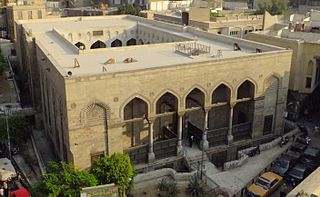
The Mosque of al-Salih Tala'i is a late Fatimid-era mosque built by the vizier Tala'i ibn Ruzzik in 1160. It is located south of Bab Zuweila, just outside the southern entrance to the old walled city of Cairo.

A continuous presence of Islam in Poland began in the 14th century. From this time it was primarily associated with the Lipka Tatars, many of whom settled in the Polish–Lithuanian Commonwealth while continuing their traditions and religious beliefs. The first significant non-Tatar groups of Muslims arrived in Poland in the 1970s, though they are a very small minority.

Kruszyniany is a village in the administrative district of Gmina Krynki, within Sokółka County, Podlaskie Voivodeship, in north-eastern Poland, close to the border with Belarus.
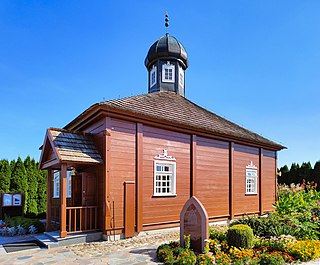
Bohoniki is a village in the administrative district of Gmina Sokółka, within Sokółka County, Podlaskie Voivodeship, in north-eastern Poland, close to the border with Belarus. It lies approximately 7 kilometres (4 mi) east of Sokółka and 42 km (26 mi) north-east of the regional capital Białystok.
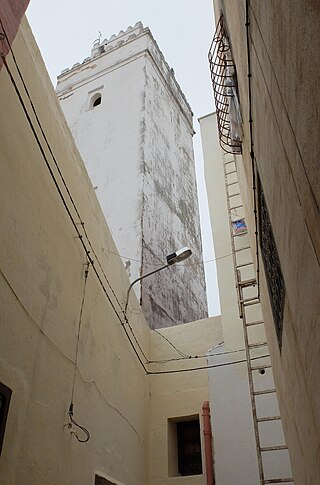
The Great Mosque of Taza is the most important religious building in the historic medina of Taza, Morocco. Founded in the 12th century, it is the oldest surviving example of Almohad architecture, although it was expanded by the Marinids in the late 13th century.

The Madrasa Bou Inania is a madrasa in Fes, Morocco, built in 1350–55 CE by Abu Inan Faris. It is the only madrasa in Morocco which also functioned as a congregational mosque. It is widely acknowledged as a high point of Marinid architecture and of historic Moroccan architecture generally.
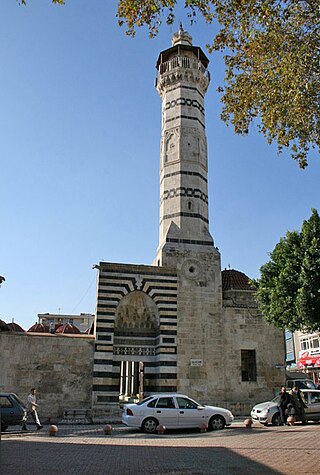
The Great Mosque of Adana, also known as the Ramazanoglu Mosque Turkish: Ramazanoğlu Camii), is a 16th-century mosque in Adana, Turkey. It forms part of a complex (külliye) that includes a madrasah and a mausoleum (türbe). The buildings are on Kızılay street, next to the Ramazanoğlu Hall.

The Sultan al-Ghuri Complex or Funerary complex of Sultan al-Ghuri, also known as al-Ghuriya, is a monumental Islamic religious and funerary complex built by Sultan Qansuh al-Ghuri between 1503 and 1505 CE. The complex consists of two major buildings facing each other on al-Mu'izz li-Din Allah street, in the Fahhamin Quarter, in the middle of the historic part of Cairo, Egypt. The eastern side of the complex includes the Sultan's mausoleum, a khanqah, a sabil, and a kuttab, while the western side of the complex is a mosque and madrasa. Today the mosque-madrasa is still open as a mosque while the khanqah-mausoleum is open to visitors as a historic site.
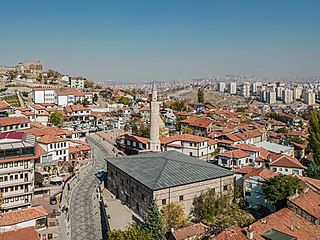
Aslanhane Mosque is a 13th-century mosque in Ankara, Turkey.

Bohoniki Mosque is a wooden mosque located in the village of Bohoniki, Podlaskie Voivodeship, in northeastern Poland.

St. Paraskevi Church in Radruż is a Gothic, wooden church from the sixteenth-century located in the village of Radruż, Poland, which together with different tserkvas is designated as part of the UNESCO Wooden tserkvas of the Carpathian region in Poland and Ukraine.

The Kasbah Mosque is a historic mosque in Marrakesh, Morocco. It was originally built by the Almohad ruler Yaqub al-Mansur in 1185-1190 CE. It is located in the Kasbah district, the city's former citadel, near the site of its historic royal palaces. Along with the Kutubiyya Mosque, it is one of the most important historic mosques in Marrakesh.

The Mosque ofAmir Qijmas al-Ishaqi or Abu Hurayba Mosque is a late Mamluk-era mosque in Cairo, Egypt. It dates from 1480-81 CE and is located in the historic al-Darb al-Ahmar district, near Bab Zuweila. It is considered by many to be one of the finest examples of late Mamluk architecture.
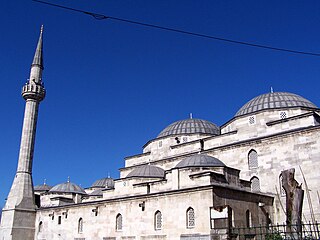
The Mahmut Pasha Mosque is a 15th-century Ottoman mosque near the Grand Bazaar in the Fatih district of Istanbul, Turkey.

The Tatar Trail of Podlaskie Voivodeship in Eastern Poland consists of two marked trails along sites related to the Lipka Tatars. The longer Szlak Tatarski Duży, marked in green, has 57 kilometers. The blue-marked Szlak Tatarski Mały is shorter at 19 kilometers of length . The attractions are mainly of historical interest. Rural tourism facilities give opportunity to meet Tatar families and learn about their culture. As it runs through the Knyszyń Forest, the trail offers insight into nature as well.

Navahrudak Mosque is a wooden mosque located in Novogrudok, Grodno Region in Belarus.

The Grand Mosque of Meknes is the historic main mosque of the old city (medina) of Meknes, Morocco. It is the largest and most important mosque in the old city and one of its oldest monuments.

The Powers Street Mosque in Brooklyn, New York City is one of the oldest mosques in the United States. It was founded by a small group of Lipka Tatars, originating from the Białystok region of Poland. This was the first Muslim organization in New York State and the first official mosque for New York City's Muslim population.

Raižiai Mosque is a wooden mosque located in the village of Raižiai, Alytus County in Lithuania. The mosque was the only one to operate during the Soviet era. The mosque remains open, with local Muslim religious gatherings during major holidays. The mosque serves as a center for activities for the 500 Tatars that live in the village.


























